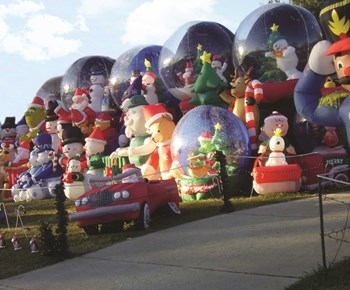
Holiday decorations are an easy way for an association to spread some seasonal cheer and add a cozy, communal vibe to the neighborhood. But what was once a practice limited to a couple of lights, ornaments and a menorah or two has migrated toward a decorating empire complete with 10-foot tall blow-up Santas, multi-color lights that pulsate and twinkle and even moving reindeer and elves, synchronized to holiday music.
While not all associations choose to outfit their buildings with such elaborate décor (or want the supersized energy bill that comes along with it), navigating the community decorating scene can be tricky at times. For co-op and condo residents, potential arguments about religious decorations can make the season a lot less festive.
This holiday, the biggest of them all, tends to create the most fuss among condo residents as childhood memories and religious intentions collide with the “rules.” So before you hang those stockings and plug in those lights you may want to check house rules and bylaws first.
Decorating 101
Whether it’s with simple lights or elaborate displays, each community differs in the type and quantity of decorations it allows. There are associations that prefer modest touches and others that sponsor full-on contests between neighbors. Regardless of the decorating preferences, guidelines can be found in the governing documents.
“Most buildings and boards have formal decorating policies. It would be very prudent to come up with a policy and apply it in a uniform manner,” says attorney Hubert Cutolo, Esq., a partner with the law firm of Cutolo Mandel LLC in Manalapan. “It’s important because you have to treat all of the members or occupants in a uniform manner. You want to make sure the policy is not discriminatory, and you want guidelines in which to enforce those. If you don’t have a policy, which doesn’t articulate what’s too much or too little in terms of decorations, you’ll obviously run into a lot of issues. A lot of associations will put standard policies in place allowing for a certain number of lights or decorations.”
In order to prevent clutter and overload, some associations may be more restrictive in terms of where seasonal fixings can be placed. Many buildings won’t allow residents to install a nativity scene in front of their door because it can create a hazard for people coming and going, which turns into a safety issue.
“I do have some associations that do have decorating resolutions that set forth what’s allowed and what’s not allowed,” says Scott B. Piekarsky, a managing member of the law firm of Pierkarsky & Associates, LLC in Wyckoff.
“It mainly deals with times frames: that the decorations don’t go up too early and that they are not taken down too late. You can’t tell people how to celebrate but they can’t have Christmas lights up during the summer. It just doesn’t look right and they shouldn’t have 500-pound pumpkins on their front steps. Some people will test you. I drafted some resolutions at communities ten to 15 years ago when they were new communities and we never had to revisit them in subsequent years. People get it, they understand what’s reasonable and they follow it.”
Religious Issues
Though the holidays typically evoke images of Christmas trees, in today’s multicultural associations it’s highly probable that residents celebrate Hanukkah, Kwanzaa or choose not to observe at all. There have even been legal battles regarding religious items.
In 2001, the condominium association at the 378-unit Shoreline Towers in Edgewater, a neighborhood in Chicago, attracted controversy when it adopted a rule banning “mats, boots, shoes, carts or objects of any sort outside unit entrance doors.” It was determined that the rule must be enforced in an absolute manner. As a result, mezuzot (small, ritual items affixed to doorposts of Jewish homes, which contain biblical verses written on parchment) were removed from residents’ doors. Numerous complaints ensued alleging housing discrimination on the basis of religion.
As a result of the controversy, Chicago’s Municipal Code was amended in 2005 to make it illegal to prohibit a renter or owner of an apartment, house or condominium from placing or affixing a religious sign, symbol or relic on the door, door post or entrance.
“Today most buildings try to keep it, let’s just say less religious and more spirited,” says Joseph J. Balzamo, president of Alliance Property Management in Morristown. “You don’t want something that clearly denotes Hanukkah, and only Hanukkah or Christmas and only Christmas, or some other religious holiday. Most buildings that I manage tend to keep things more neutral. For example, if they are going to decorate around a sign they will use poinsettias or white lights.”
Experts note that because we live in a multi-faith society, it's just simple courtesy and good neighborliness to be as inclusive as possible. “We try to steer clear and try not to deal with that subject [religion] in content or scope,” says Piekarsky. “You have people celebrating Christmas, Hanukkah and Kwanzaa during the same period. Some people like religious statuary and some don’t. Some people like menorahs, some don’t. As long as it’s reasonable in scope, it’s not a problem. Most people are pretty reasonable. This year you have Thanksgiving and Hanukkah on the same day. Hopefully, everyone will be well-behaved.”
Making Peace
If an association is constantly dealing with problems related to seasonal décor, implementing a total ban might be seen as tempting but many courts might consider it unreasonable. Most residents enjoy holiday displays and prohibiting them could lead them to question their freedom of speech and religion.
“In my opinion the best way to avoid battles over decorations is to have a set policy in place,” says Balzamo. “People are allowed to worship in any way they want. I try to stick with having a policy that the board adheres to the situation. I think for the most part homeowners and boards alike need to be mindful that keeping the lights on all year long is not really healthy for the property. I think it’s important for boards to establish a policy and make sure that all homeowners are aware or it so it cuts down on confusion for them.”
Cutolo agrees with Balzamo that there should be a concrete policy in place to avoid bad feeling and unnecessary legal entanglements. “It’s important to have a formal policy, and it should be written up in a resolution and filed with the county clerk,” he says. “It will put everybody on notice so they’ll know what the guidelines are and what type of decorations they can place and any time limitations as well.”
“If you want to avoid conflicts you should let the residents know when the decorations can go up and when they must come down,” says Piekarsky. “What areas they are permitted to decorate in and what areas they aren’t permitted to decorate in. We don’t want people fooling around with roof areas that have warranties, there’s really no need for stuff to be on the roof and it’s dangerous for residents to be up there. But by publishing it, getting it out, adopting it in a form of resolution and even including the community in the discussion when you adopt the resolution is a good idea. That’s the best way to handle it. I haven’t had a problem or an issue come up in many, many years.”
Harmonious Holidays
Decorating a community for the holidays can be tough, especially with differences in culture and expectations. And while some boards experience residents going a little overboard with lights and trimmings, in general, seasonal enhancements aren’t too painful and have some great benefits for the community as a whole such as fostering camaraderie among the residents and promoting a festive, holiday spirit within the community.
The general consensus is that tasteful, seasonal decorations have a way of spreading good cheer during the holiday season and residents of cooperative and condominium housing want to be part of a community or they’d live in a remote, cabin deep in the woods of Maine.
Christy Smith-Sloman is a staff writer at The New Jersey Cooperator. Freelance writer Maggie Puniewska contributed to this article.






Leave a Comment